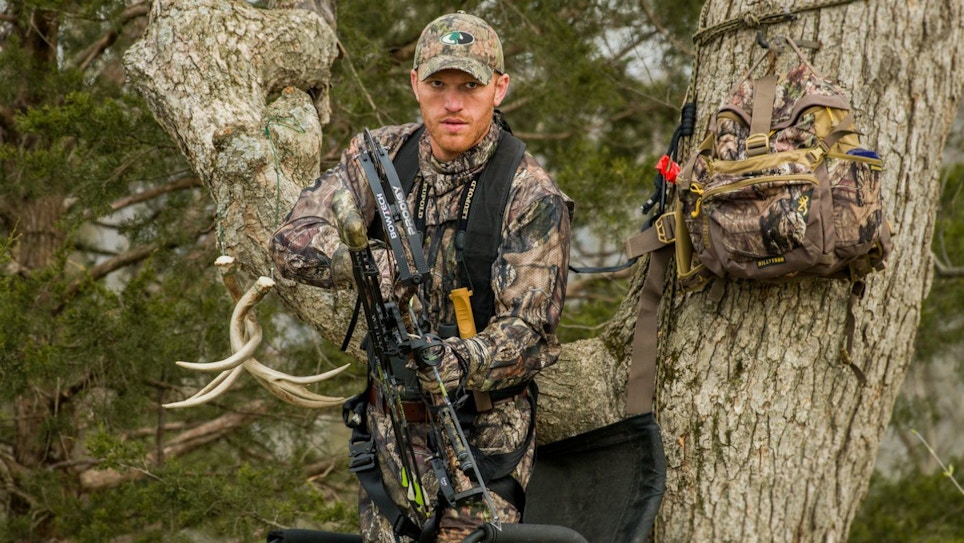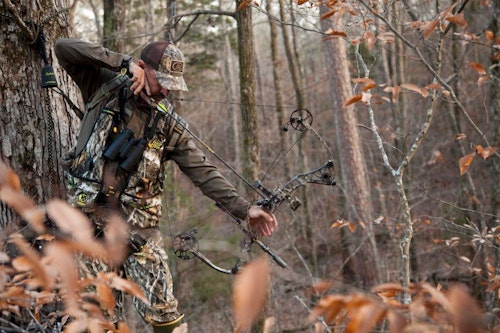How to Draw a Bow in a Tree Stand

One aspect I love about bowhunting is every shooting opportunity is unique. Just when you think you've seen or experienced everything, some new wrinkle appears as you attempt to draw your bow and tag an animal with archery tackle.
For that reason, it's impossible to provide hard-and-fast rules like "do this" and "don't do this" and have the recommendation be helpful to beginning bowhunters. That said, I will provide one bit of advice I received almost 45 years ago — words of wisdom I remember every time I'm in the field. My dad said, "If you can see a deer's eyes, then it can see you move. Wait for a deer's eyes to be blocked in some way before drawing your bow."
When Dad taught me this important lesson, we were both shooting recurves, which increases the degree of difficulty significantly over a compound. With traditional tackle, you can't draw early and wait for an animal to work itself into an ideal shooting position. Instead, you must begin drawing your recurve or longbow a second — maybe two — before you'll release the string. For that reason, the deer will be close when you move to draw your bow, which increases the chances it sees you. Not easy!
To accomplish this task with recurves, Dad explained the need to have blocking cover set up on both sides of a shooting lane. "The idea is you'll see a deer coming," he said, "and you can get ready to draw. The moment its eyes are blocked by the cover, draw your bow and find your anchor. A split-second later the deer should appear in your lane and you can aim and fire."
Of course, it's easier to write this game plan in words than it is to pull off in the field. The good news for bowhunters who choose a compound over traditional bow is you have more time — and more possible eye blockers — in play as a woodland whitetail nears your shooting lane.
In general, if a deer is walking steadily toward a shooting lane, I like to draw so I can slowly and surely find my anchor point, then slowly and surely find the correct sight pin for the distance, then slowly and surely move my index finger from behind the release trigger to in front of it. When I'm not rushed, I like to take three or four seconds to accomplish these moves. (Of course, if I must do it in 1.5 seconds, I will.) After I've finished these preliminary moves, I don't mind holding at full draw for 5-10 seconds. If I've timed it right, my arrow will be on its way in this window. I'll hold longer if needed, but my accuracy suffers.
Working back in terms of time, if I like up to 10 seconds at full draw, and I take three or four seconds to get totally set at full draw, then I want to make my first move when a deer is 13 or 14 seconds away from my shooting lane. So, taking my dad's advice to heart, that means I want to have the animal's eyes blocked when it's 13 or 14 seconds away from my shooting lane.
Depending on how fast a woodland whitetail is walking, this distance from the shooting lane can vary a bit. In general, I search for eye-blocking cover to draw my bow when a deer is 15-20 yards from entering my shooting lane. If I wait too long and it's only 5 yards from my shooting lane, then I could be rushed. If I draw when a deer is 30 yards from my shooting lane, then chances are high I'll have to hold at full draw longer than desired.
Keeping these factors in mind, I search for eye-blocking cover along a deer trail 15 to 20 yards on both sides of my primary shooting lane. If large-diameter trees are present in this zone (trees big enough that I won't be able to see a deer's eyes), then I commit them to memory and I'm good to go. However, if no such big trees are present in the right spots, then I add eye-blocking cover at the time I place my treestand or ground blind. Typically I can find logs on the forest floor to prop up against saplings, or cut a brushy sapling (where legal) and move it into position along the deer trail so it blocks my view of a deer's eyes as it approaches the shooting lane.
You can't shoot if you don't draw — that's obvious. But knowing when to draw your bow — not too early, not too late — takes some experience in the field. Find or build eye-blocking cover and then use it every time to keep from being busted by woodland whitetails while drawing your bow.

When whitetails appear off the planned deer trail, you'll need to improvise when it comes to drawing your bow undetected. Just remember: If you can see a deer's eyes, then it can see you move.
Source: https://www.grandviewoutdoors.com/bowhunting/when-to-draw-your-bow-on-woodland-whitetails
0 Response to "How to Draw a Bow in a Tree Stand"
Post a Comment